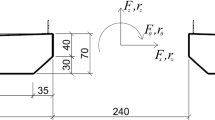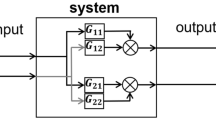Abstract
In this paper a nonlinear multi-input multi-output (MIMO) aeroelastic systems’ Volterra kernel identification (VKI) is carried out by expansion of the Volterra kernels in terms of scale functions and multiwavelet functions employing multiresolution. The resulting system of discretized Volterra equations is solved through least square method employing singular value decomposition. A new algorithm for solution of the discretized Volterra equations is proposed which is beneficial for solution on computers with limited memory resources. A new input excitation signal is presented for simultaneous excitation of MIMO unsteady aerodynamic response. The identified MIMO Volterra kernels include first order and second order self-interaction and cross-interaction kernels of the system. The results from the VKI based reduced order model is compared with the coupled computational fluid dynamics and computational structural dynamics simulation of an aeroelastic wing.
Similar content being viewed by others
References
Cowan TJ, Arena AS, Gupta KK (1999) Development of a discrete-time aerodynamic model for CFD-based aeroelastic analysis. In: 37th AIAA aerospace sciences meeting and exhibit, Reno, NV
Valasek J, Chen W (2003) Observer/Kalman filter identification for online system identification of aircraft. J Guid Control Dyn 26: 347–353
Silva WA, Raveh DE (2001) Development of unsteady aerodynamic state-space models from CFD-based pulse responses. In: 42nd AIAA/ASME/ASCE/AHS/ASC structures structural dynamics, and materials conference and exhibit, Seattle, WA
Hyland DC, Scharf DP (1999) Adaptive neural control for MACE II. In: AIAA 1999 space technology conference and exposition, Albuquerque, NM
Baldelli DH, Chen PC, Liu DD, Lind R, Brenner M (2004) Nonlinear aeroelastic modeling by block-oriented identification. In: 45th AIAA/ASME/ASCE/AHS/ASC structures, structural dynamics & materials conference, Palm Springs, CA
Baldelli DH, Lind R, Brenner M (2005) Nonlinear aeroelastic/aeroservoelastic modeling by block-oriented identification. J Guid Control Dyn 28: 1056–1064
Kurdila A, Prazenica C, Rediniotis O, Strganac T (1999) Multiresolution methods for reduced order models for dynamical systems. In: 40th AIAA/ASME/ASCE/AHS/ASC structures, structural dynamics, and materials conference and exhibit, St. Louis, MO
Reisenthel PH (1999) Prediction of unsteady aerodynamic forces via nonlinear kernel identification. In: CEAS/AIAA/ICASE/ NASA langley international forum on aeroelasticity and structural dynamics, Williamsburg, pp 1–10
Silva WA (1999) Reduced order models based on linear and nonlinear aerodynamic impulse responses. In: AIAA/ASE/ASCE/ AHS/ASC 40th structures, structural dynamics, and materials conference, St. Louis, MO
Liu F, Cai J, Tsai H (2000) Flutter predictions by a filtered impulse method. In: AIAA 18th applied aerodynamics specialist conference & exhibit, Denver, CO
Raveh DE (2000) Reduced order models for nonlinear unsteady aerodynamics. In: 8th AIAA/USAF/NASA/ISSMO symposium on multidisciplinary analysis-and optimization, Long Beach, CA
Marzocca P, Librescu L, Silva WA (2001) Volterra series approach for nonlinear aeroelastic response of 2-D lifting surfaces. In: 42nd AIAA/ASME/ASCE/AHS/ASC structures, structural dynamics, and materials conference & exhibit, Seattle, WA
Lind R, Prazenica RJ, Brenner MJ (2003) Estimating nonlinearity using Volterra kernels in feedback with linear models. In: 44th AIAA/ASME/ASCE/AHS structures, structural dynamics, and materials conference, Norfolk, VA
Prazenica RJ, Lind R, Kurdila AJ (2003) Uncertainty estimation from Volterra kernels for Robust Flutter analysis. J Guid Control Dyn 26: 331–339
Romanowski MC, Dowell EH (1996) Reduced order Euler equations for unsteady aerodynamic flows: numerical techniques. In: AIAA 34th aerospace sciences meeting and exhibit, Reno, NV
Hall KC (1994) Eigenanalysis of unsteady flows about airfoils, cascades, and wings. AIAA J 32: 2426–2432
Baker ML, Mingori DL, Goggin PJ (1996) Reduced order models of unsteady aerodynamic systems approximate subspace iteration for constructing internally balanced reduced order models of unsteady aerodynamic systems. In: 37th AIAA/ASME/ ASCE/AHS/ASC structures, structural dynamics and materials conference and exhibit, Salt Lake City, UT, pp 1070–1085
Hindman C, Balas M, Lesoinne M (2001) A reduced order eigenmodel for an aeroelastic airfoil. In: AIAA guidance, navigation, and control conference and exhibit, Montreal, Canada
Romanowski MC (1996) Reduced order unsteady aerodynamic and aeroelastic models using Karhunen-Loeve eigenmodes. In: AIAA 34th aerospace sciences meeting and exhibit, Reno, NV
Hall KC, Thomas JP, Dowell EH (1999) Reduced order modeling of unsteady flows using a frequency domain proper orthogonal decomposition technique. In: 37th aerospace sciences meeting and exhibit, Reno, NV
Willcox K, Perairet J (2001) Balanced model reduction via the proper orthogonal decomposition. In: 15th AIAA computational fluid dynamics conference, Anaheim, CA
Tan BT (2003) Proper orthogonal decomposition extensions and their applications in steady aerodynamics. Master’s thesis, Singapore-MIT Alliance, Singapore
Willcox K (2004) Unsteady flow sensing and estimation via the gappy proper orthogonal decomposition. In: 2nd AIAA flow control conference, Portland, ON
Lieu T, Farhat C, Lesoinne M (2005) POD-based aeroelastic analysis of a complete F-16 configuration: ROM adaptation and demonstration. In: 46th AIAA/ASME/ASCE/AHS/ASC structures, structural dynamics & materials conference, Austin, TX, pp 1–16
Burkardt J, Gunzburger M, Lee H (2006) POD and CVT-based reduced-order modeling of Navier-Stokes flows. Comput Methods Appl Mech Eng 196: 337–355
Willcox K, Peraire J, White J (2000) An Arnoldi approach for generation of reduced-order models for turbomachinery. In: 38th aerospace sciences meeting & exhibit, Reno, NV
Attar PJ, Dowell EH, White JR, Thomas JP (2006) Reduced order nonlinear system identification methodology. AIAA J 44: 1895–1904
Hall KC, Thomas JP (2003) Frequency domain techniques for complex and nonlinear flows in turbomachinery. In: 33rd AIAA fluid dynamics conference and exhibit, Orlando, FL
Hall KC, Kielb RE, Ekici K, Thomas JP, Carolina N, Clark WS (2005) Recent advancements in turbomachinery aeroelastic design analysis. In: 43rd AIAA aerospace sciences meeting and exhibit, Reno, NV
Vio GA, Dimitriadis G, Cooper JE (2007) Bifurcation analysis and limit cycle oscillation amplitude prediction methods applied to the aeroelastic galloping problem. J Fluids Struct 23: 983–1011
Amuyedo N, Cooper JE (2007) Higher order harmonic balance analysis of an airfoil with a hysteretic non-linearity. In: 48th AIAA/ASME/ASCE/AHS/ASC structures, structural dynamics, and materials conference, Honolulu, Hawaii
Liu L, Thomas JP, Dowell EH, Attar P, Hall KC (2006) A comparison of classical and high dimensional harmonic balance approaches for a duffing oscillator. J Comput Phys 215: 298–320
Silva WA (1993) Modeling transonic aerodynamic response using nonlinear systems theory for use with modern control theory. In: Guidance, navigation, controls, and dynamics for atmospheric flight workshop, Hampton, VA
Silva (WA) (1997) Identification of linear and nonlinear aerodynamic impulse responses using digital filter techniques. In: AIAA atmospheric flight mechanics conference, New Orleans, LA
Kurdila A, Prazenica C, Rediniotis O, Strganac T (1999) Multiresolution methods for reduced order models for dynamical systems. In: 1999 AIAA/ASME/ASCE/AHS/ASC structures, structural dynamics, and materials conference and exhibit
Prazenica RJ, Kurdila AJ, Silva W (2000) Multiresolution methods for representation of Volterra series and dynamical systems. In: 41st AIAA/ASME/ASCE/AHS/ASC structures, structural dynamics, and materials conference and exhibit, Atlanta, GA
Raveh DE (2000) Reduced order models for nonlinear unsteady aerodynamics. In: 8th AIAA/USAF/NASA/ISSMO symposium on multidisciplinary analysis and optimization, Long Beach, CA
Marzocca P, Librescu L, Silva WA (2001) Volterra series approach for nonlinear aeroelastic response of 2-D lifting surfaces’. In: 2nd AIAA/ASME/ASCE/AHS/ASC structures, structural dynamics, and materials conference and exhibit, SEATTLE, WA
Raveh DE, Mavris1 DN (2001) Reduced-order models based on CFD impulse and step responses. In: 42nd AIAA/ASME/ASCE/ AHS/ASC structures, structural dynamics, and materials conference and exhibit, SEATTLE, WA, p 13
Munteanu SL, Rajadas J, Nam C, Chattopadhyay A (2004) An efficient approach for solving nonlinear aeroelastic phenomenon using reduced-order modeling. In: 45th AIAA/ASME/ASCE/AHS/ASC structures, structural dynamics & materials conference, Palm Springs, CA
Prazenica RJ, Reisenthel PH, Kurdila AJ (2004) Volterra kernel identification and extrapolation for the F/A-18 active aeroelastic wing. In: 45th AIAA/ASME/ASCE/AHS/ASC structures, structural dynamics & materials conference, Palm Springs, CA, pp 1–18
Prazenica RJ, Kurdila AJ (2006) Multiwavelet constructions and Volterra kernel identification. Nonlinear Dyn 43: 277–310
Ogunfunmi T (2007) Adaptive nonlinear system identification the Volterra and Wiener model approaches. Springer, Santa Clara
Zhang Q, Suki BE, Westwick DT, Lutchen KR (1998) Factors affecting Volterra kernel estimation: emphasis on lung tissue viscoelasticity. Ann Biomed Eng 26: 103–116
Rugh WJ (2002) Nonlinear system theory. The Johns Hopkins University Press, Baltimore
Dankers A, Westwick D (2006) Nonlinear system identification using optimally selected Laguerre filter banks. In: Proceedings of the 2006 American control conference, Minneapolis, MN, p. 2369–2374
Seretis C, Zafirioul E (1997) Nonlinear dynamical system identification using reduced Volterra models with generalized orthonormal basis functions. In: Proceedings of the American control conference, Albuquerque, NM, pp 3042–3046
Nelles O (2001) Nonlinear system identification from classical approaches to neural networks and fuzzy models. Springer-Verlag, Berlin, Heidelberg
Delport R (2005) Process identification using second order Volterra models for nonlinear model predictive control design of flotation circuits. Process identification using second order predictive control design of flotation circuits
Soni AS (2006) Control-relevant system identification using nonlinear Volterra and Volterra-Laguerre model. PhD Thesis, University of Pittsburgh
Balajewicz M, Nitzsche F, Feszty D (2008) On the application of multi-input Volterra theory to nonlinear multi-degree-of-freedom aerodynamic systems. In: 49th AIAA/ASME/ASCE/AHS/ASC structures, structural dynamics, and materials conference, Schaumburg, IL
Balajewicz M, Nitzsche F, Feszty D (2009) Reduced order modeling of nonlinear transonic aerodynamics using a pruned Volterra series. In: 50th AIAA/ASME/ASCE/AHS/ASC structures, structural dynamics, and materials conference, Palm Springs, CA
Orcioni S (2005) Advances in Lee–Schetzen method for Volterra. Multidimens Syst Signal Process 16: 265–284
Prazenica RJ, Lind R, Kurdila AJ (2002) Uncertainty estimation from Volterra kernels for robust flutter analysis. In: 43rd AIAA/ASME/ASCE/AHS/ASC structures, structural dynamics, and materials conference
Brenner MJ, Prazenica RJ (2003) Aeroservoelastic model validation and test data analysis of the F/A-18 active aeroelastic wing. In: NASA/TM-2003-212021, California
Prazenica RJ, Reisenthel PH, Kurdila AJ, Brenner MJ (2007) Volterra kernel extrapolation for modeling nonlinear aeroelastic systems at novel flight conditions. J Aircr 44: 149–162
Silva W (2005) Identification of nonlinear aeroelastic systems based on the Volterra theory: progress and opportunities. Nonlinear Dyn 39: 25–62
Khawar J, Ghafoor A, Chao Y (2011) Validation of CFD-CSD coupling interface methodology using commercial codes. Int J Numer Methods Fluids 65(5): 475–495
Author information
Authors and Affiliations
Corresponding author
Rights and permissions
About this article
Cite this article
Khawar, J., Zhigang, W. & Chao, Y. Volterra kernel identification of MIMO aeroelastic system through multiresolution and multiwavelets. Comput Mech 49, 431–458 (2012). https://doi.org/10.1007/s00466-011-0655-9
Received:
Accepted:
Published:
Issue Date:
DOI: https://doi.org/10.1007/s00466-011-0655-9




